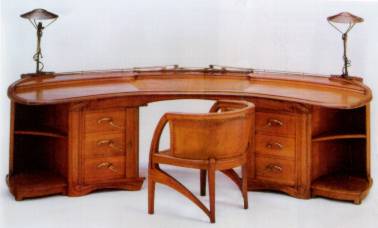
An extraordinary oalk, brone and leather desk aed chair,
designed by Henri Clemens van de Velde
c.1898; ht 50in/128cm, wdth l05in/267cm, value code A
FURNITURE
HENRI van de VELDE

An extraordinary oalk, brone and leather desk aed chair,
designed by Henri Clemens van de Velde
c.1898; ht 50in/128cm, wdth l05in/267cm, value code A
1. Does the piece incorporate both curved and straight lines?
2. Is it relatively restrained, and free of applied decoration?
3. Is the form balanced?
4. Does the design combine original forms with traditional infuences?
5. Is the piece substantial in appearance?
6. Is it sculptural?
7. Are any metalwork fittings sympathetic to the piece, and perhaps of whiplash form?
8. Does any upholstery have beaded studwork?
9. Is the piece praclical?
10. If a chair, are any splats slender?
11. Are any feet chamfered, and curved slightly outwards?
Henri Clemens van de Velde (Belgian, 1863-1957)
Henri Clemens van de Velde trained as a painter, architect and graphic designer
in Antwerp and Paris, and was instrumental in the evolution of the Belgian Art Nouveau
style. He designed all manner of items, including whole interiors, but was particularly
influential in the fields of furniture, ceramics, jewelry and metalwork. His work was
produced mainly to commission.
Van de Velde's furniture designs Van de Velde's furniture tends to be substantial, with restrained, sculptural forms. In the manner of the Paris School, pieces rely on form for interest, rather than the applied decoration and inlay commonly used by adherents of the Nancy School. Practicaliry is never sacrificed for the sake of design the drawers of this unusual desk are all within casy reach. Rather, design works wich function the light fitting of this desk is incorporated into the piece. The electrical wire is trained through the metal gallery rail at the back of the desk. The railing is in a whiplash form, a common theme for his metalwork finings. * The unusual desk chair echoes the fluid architectural forms of
the French architect, Hector Guimard, rather than the work of Art Nouveau cabinet makers
such as Louis Marjorelle (see page). Availability |
Marks Although porcelain designs by van de Velde are usually marked, his furniture rarely is. However, contemporary photographs of his work exist, which facilitates the search for the provenance of some pieces. Innovation versus tradition The armchair above has a traditional feel, despite the innovative
interplay of uprights and horizontals. The way in which the arm rests overlap the upright
back rails is typical of van de Velde's work, as are the slender splats and generally
spartan design and decoration. |